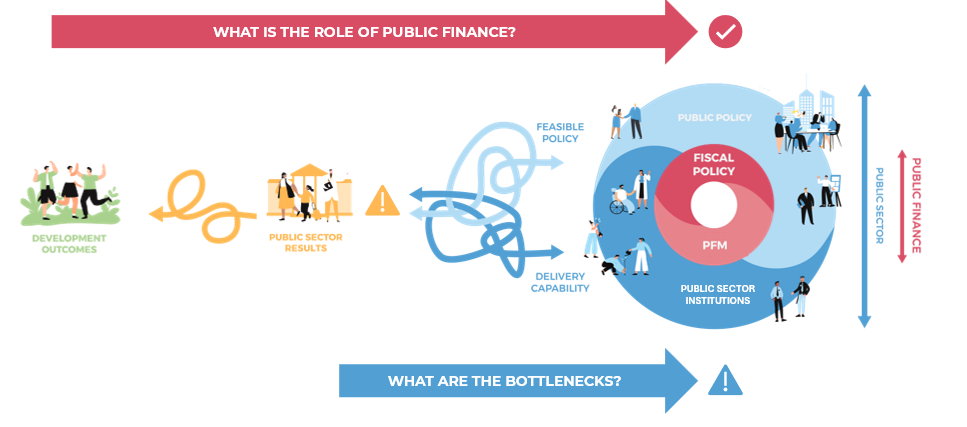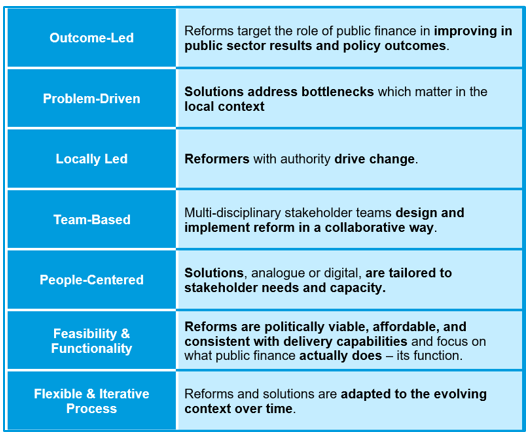We welcome the debate that the Reimagining Public Finance Initiative has sparked amongst the PFM community on how to strengthen our approaches to reform. This blog responds to some of the concerns raised during the debate about the outcome-led approach to PFM reform put forward by the initiative – and specifically those raised by Richard Allen in his recent blog “Reimagining PFM – An Incomplete Agenda?” and at our recent conference.
An overarching concern is that the intention of the Initiative is to replace the current approach to PFM reform that has evolved over recent decades. It is not. It is intended to put the tools that have been developed to better use. The initiative does not question the value of introducing, for example, a medium-term budget framework, cash management and commitment controls, treasury single accounts, or risk-based auditing. And it recognizes the value of existing diagnostic instruments—such as PEFA, PIMA and TADAT—that assess the quality of PFM systems, and of government efforts to strengthen them. It simply tries to reconnect these efforts with the broader overall objective of improving public sector results and development outcomes.
Figure 1: The Outcome Led Analytical Approach

The proposed outcome-led approach (depicted in Figure 1) asks the question: what is the role of public finance in achieving development outcomes? The last three of the four roles of public finance identified by our research (commitment to feasible policy, fiscal sustainability, effective resource mobilization and distribution, and performance and accountability in delivery) are anchored in and build on the three established objectives of public finance included in the World Bank's 1998 PEM Handbook.
The approach then asks a second question: what are the bottlenecks which prevent public finance from playing those roles effectively? In answering these questions for a set of policy priorities in a country, the intention is to sharpen the focus of PFM reforms so that they are better targeted on problems that impact development rather than just conforming with international good practice.
This approach is well suited to Richard's proposed scenarios of countries introducing universal health coverage and free basic education policies, which have implications for both expenditure policy and for PFM reform – and both need to be addressed together, not as separate agendas. The outcome-led approach works at the interface of public policy, PFM, and the broader institutional context in which they function, and emphasizes their interdependence.
Such an approach does not have to be limited to service delivery sectors such as health and education, but can be applied to policies related to “economic development and fiscal stabilization” – and has been applied to economic resilience. In fact, the approach is best applied to a combination of such policies – so that policy trade-offs can be confronted, and transversal, government-wide bottlenecks identified and addressed in PFM reforms.
Some concerns have also been raised that implementing this agenda will add to reform complexity and be more time-consuming. In our view, it has the potential to do the opposite – to lead to a more focused, manageable and impactful PFM reform agenda and more focused dialogue on meaningful results. To illustrate, in a single day’s workshop in Kenya in 2016, asking a collection of senior managers “What are the challenges that PFM presents for economic management and service delivery?” initially yielded agreement of six PFM bottlenecks, which subsequently became the focus of reform.
Figure 2: Principles of PFM Reform

The proposed approach sets out principles (figure 2) that address common challenges in PFM reform:
- Reforms that are more targeted, focused on addressing PFM bottlenecks that matter for development, identified and backed by local reformers, thereby “reducing the number of PFM reforms”.
- Reforms that are crafted and implemented by multi-disciplinary teams working across institutional silos in a flexible, iterative and adaptive way, helping in “unwinding the organizational silos” associated with reform.
- Solutions that are user-centric, feasible, functional, and aligned to user needs and capabilities, contributing to reducing “the complexity of PFM reforms” and “making better use of [...] economists, accountants, financial managers, IT specialists and other skilled workers”.
- Reforms that are sustained by unlocking and building institutional capability of finance and sectors across government, including both “finance ministries and finance/budget departments in key line ministries” as well as subnational entities and frontline providers.
- Support to PFM reform, which is focused on the achievement of locally defined reform results that resolve bottlenecks and unlock the potential of public finance, which involves the IMF Fiscal Affairs Department and the World Bank and other partners “working collaboratively” with government leaders and teams to achieve this.
In sum, the outcome led-approach uses the prerogative of delivering against public policy priorities as a motivator and opportunity for more focused and impactful PFM reform—and uses PFM reform to help discipline and drive the implementation of priority public policies.
The Reimagining Public Finance Initiative is benefiting from these debates. As we continue to refine the approach, we welcome further reflections on the proposal.




